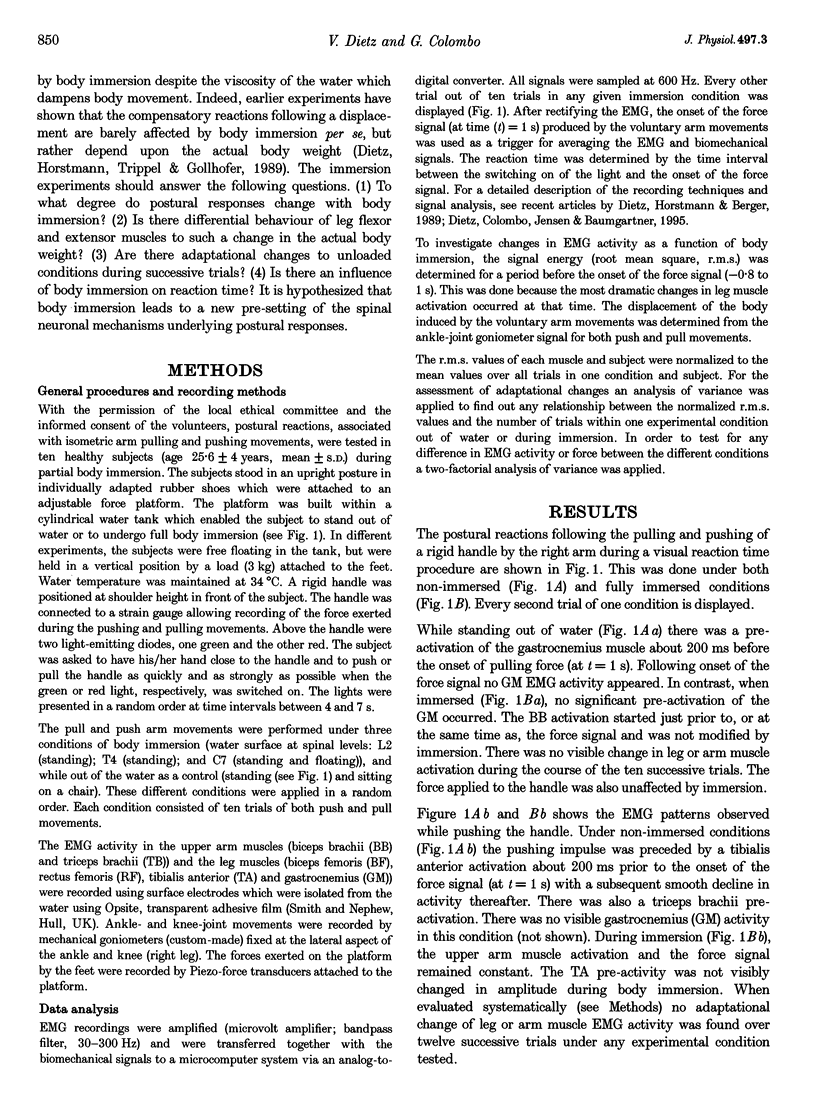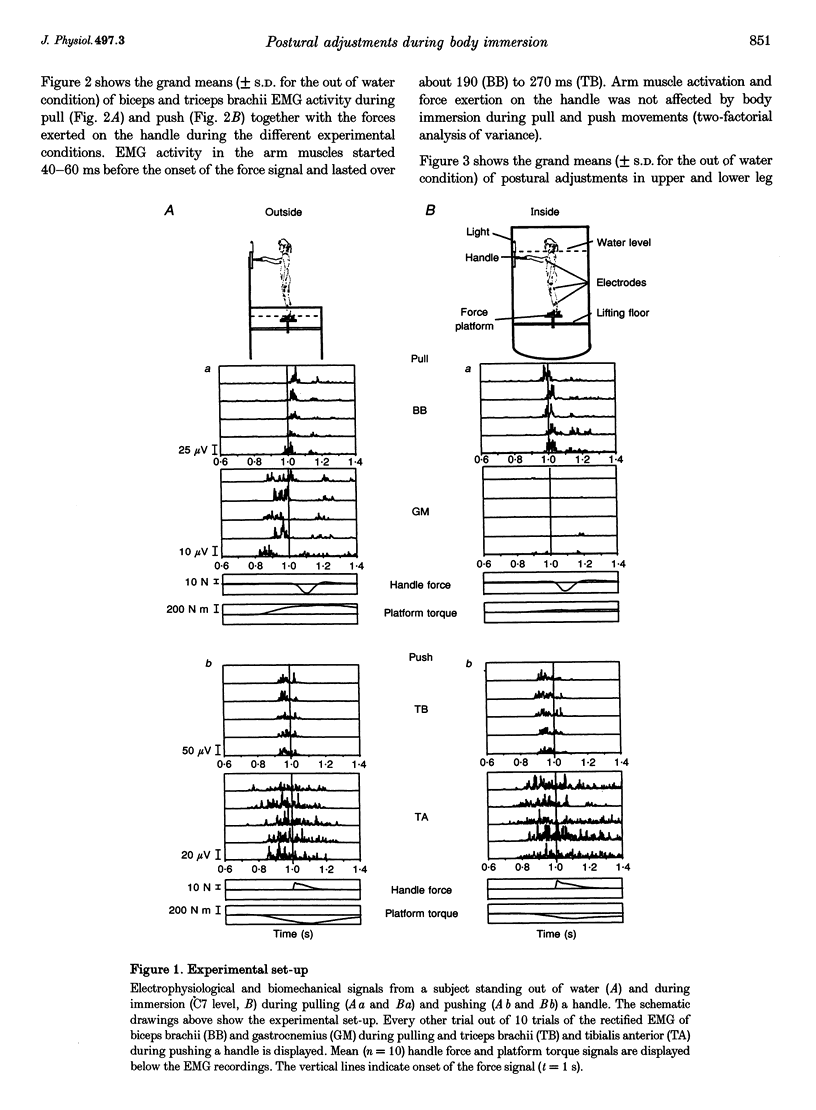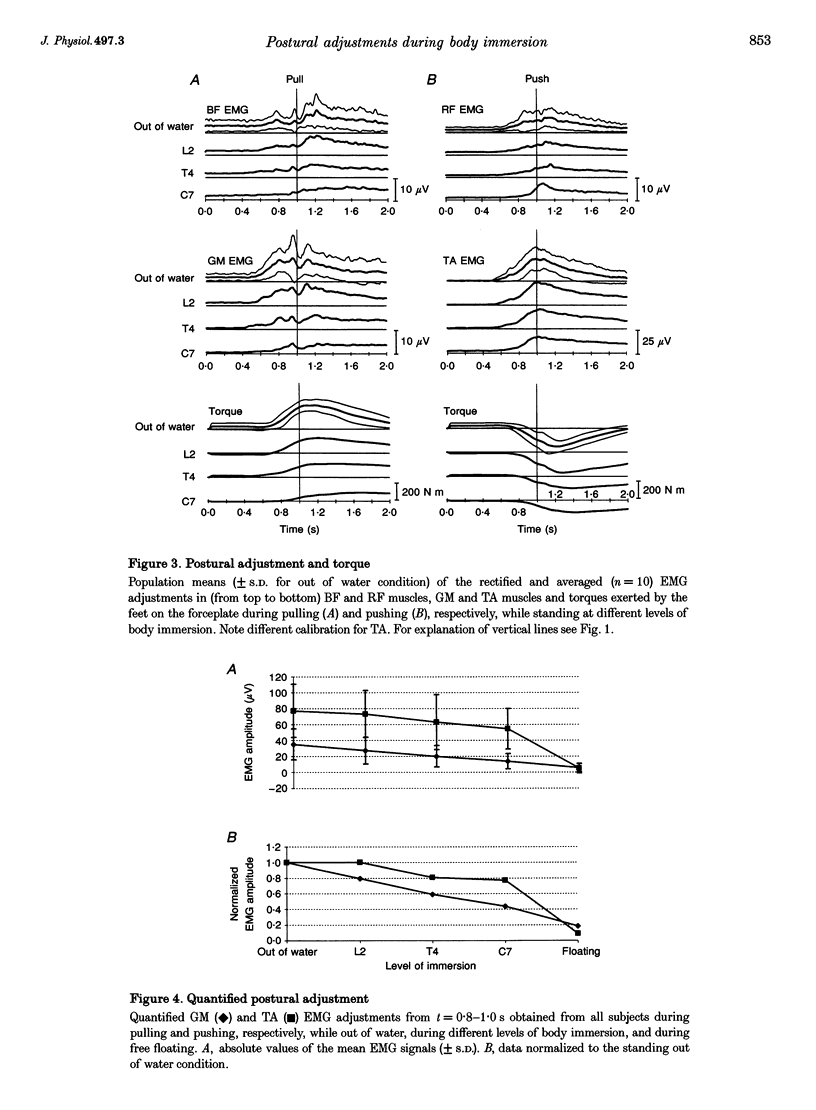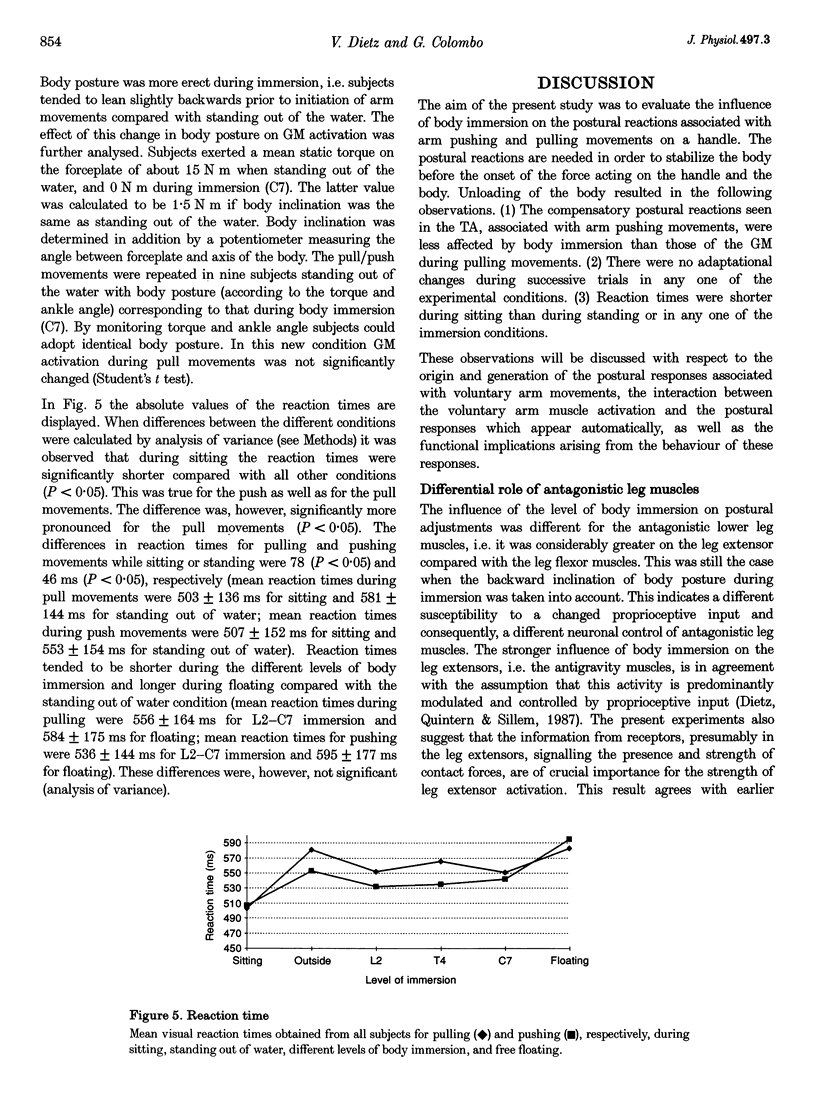Abstract
1. The effect of body immersion on postural adjustments was studied in ten healthy subjects. Reaction times, for pushing or pulling a rigid handle, in response to a visual stimulus were measured. In addition EMG recordings were taken from upper arm and lower leg muscles during three levels of body immersion while standing on a platform (immersed to spinal levels: lumbar nerve root 2 (L2); thoracic nerve root 4 (T4); and cervical nerve root 7 (C7)), while floating and while standing or sitting out of water. 2. With increasing levels of body immersion there was a near linear reduction in the amplitude of the gastrocnemius (GM) EMG activity before (200 ms) the onset of a force signal from pulling, but immersion had a significantly weaker effect on the amplitude of the tibialis anterior (TA) EMG during pushing movements. There was no significant difference in the effect of body immersion on biceps femoris (BF) and rectus femoris (RF). Under free-floating conditions postural adjustments did not occur in response to pull or push movements. There were no adaptational changes of EMG adjustments during successive trials at a given immersion level. 3. Under non-immersed conditions reaction times were significantly shorter during sitting than during standing. This difference is assumed to be due to the postural adjustments required while standing before the onset of a voluntary arm movement. While standing, reaction times were significantly longer for pull compared with push movements. Under all conditions of body immersion the reaction times remained longer compared with the sitting condition, even when no leg muscle EMG adjustments were present. 4. It is assumed that the differential effect of body immersion on the antagonistic leg muscles is due to the differential neuronal control of antagonistic leg muscles with a strong influence from proprioceptive input (most probably from load receptors) on the leg extensors. The longer reaction times seen during body immersion, where no postural adjustments were evident, suggests that a supraspinal command to the leg muscles precedes the voluntary arm movement. However, because of the changed/decreased afferent input no postural adjustments are generated.
Full text
PDF







Selected References
These references are in PubMed. This may not be the complete list of references from this article.
- Aruin A. S., Latash M. L. Directional specificity of postural muscles in feed-forward postural reactions during fast voluntary arm movements. Exp Brain Res. 1995;103(2):323–332. doi: 10.1007/BF00231718. [DOI] [PubMed] [Google Scholar]
- Bouisset S., Zattara M. Biomechanical study of the programming of anticipatory postural adjustments associated with voluntary movement. J Biomech. 1987;20(8):735–742. doi: 10.1016/0021-9290(87)90052-2. [DOI] [PubMed] [Google Scholar]
- Brouwer B., Ashby P. Corticospinal projections to lower limb motoneurons in man. Exp Brain Res. 1992;89(3):649–654. doi: 10.1007/BF00229889. [DOI] [PubMed] [Google Scholar]
- Dick J. P., Rothwell J. C., Berardelli A., Thompson P. D., Gioux M., Benecke R., Day B. L., Marsden C. D. Associated postural adjustments in Parkinson's disease. J Neurol Neurosurg Psychiatry. 1986 Dec;49(12):1378–1385. doi: 10.1136/jnnp.49.12.1378. [DOI] [PMC free article] [PubMed] [Google Scholar]
- Dietz V., Colombo G., Jensen L., Baumgartner L. Locomotor capacity of spinal cord in paraplegic patients. Ann Neurol. 1995 May;37(5):574–582. doi: 10.1002/ana.410370506. [DOI] [PubMed] [Google Scholar]
- Dietz V., Gollhofer A., Kleiber M., Trippel M. Regulation of bipedal stance: dependency on "load" receptors. Exp Brain Res. 1992;89(1):229–231. doi: 10.1007/BF00229020. [DOI] [PubMed] [Google Scholar]
- Dietz V., Horstmann G. A., Berger W. Interlimb coordination of leg-muscle activation during perturbation of stance in humans. J Neurophysiol. 1989 Sep;62(3):680–693. doi: 10.1152/jn.1989.62.3.680. [DOI] [PubMed] [Google Scholar]
- Dietz V., Horstmann G. A., Trippel M., Gollhofer A. Human postural reflexes and gravity--an under water simulation. Neurosci Lett. 1989 Dec 4;106(3):350–355. doi: 10.1016/0304-3940(89)90189-4. [DOI] [PubMed] [Google Scholar]
- Dietz V. Human neuronal control of automatic functional movements: interaction between central programs and afferent input. Physiol Rev. 1992 Jan;72(1):33–69. doi: 10.1152/physrev.1992.72.1.33. [DOI] [PubMed] [Google Scholar]
- Dietz V., Quintern J., Sillem M. Stumbling reactions in man: significance of proprioceptive and pre-programmed mechanisms. J Physiol. 1987 May;386:149–163. doi: 10.1113/jphysiol.1987.sp016527. [DOI] [PMC free article] [PubMed] [Google Scholar]
- Dietz V., Schubert M., Trippel M. Visually induced destabilization of human stance: neuronal control of leg muscles. Neuroreport. 1992 May;3(5):449–452. doi: 10.1097/00001756-199205000-00018. [DOI] [PubMed] [Google Scholar]
- Duysens J., Pearson K. G. Inhibition of flexor burst generation by loading ankle extensor muscles in walking cats. Brain Res. 1980 Apr 14;187(2):321–332. doi: 10.1016/0006-8993(80)90206-1. [DOI] [PubMed] [Google Scholar]
- Massion J. Movement, posture and equilibrium: interaction and coordination. Prog Neurobiol. 1992;38(1):35–56. doi: 10.1016/0301-0082(92)90034-c. [DOI] [PubMed] [Google Scholar]
- Nashner L. M. Adapting reflexes controlling the human posture. Exp Brain Res. 1976 Aug 27;26(1):59–72. doi: 10.1007/BF00235249. [DOI] [PubMed] [Google Scholar]
- Palmer E., Downes L., Ashby P. Associated postural adjustments are impaired by a lesion of the cortex. Neurology. 1996 Feb;46(2):471–475. doi: 10.1212/wnl.46.2.471. [DOI] [PubMed] [Google Scholar]
- Pearson K. G., Collins D. F. Reversal of the influence of group Ib afferents from plantaris on activity in medial gastrocnemius muscle during locomotor activity. J Neurophysiol. 1993 Sep;70(3):1009–1017. doi: 10.1152/jn.1993.70.3.1009. [DOI] [PubMed] [Google Scholar]


